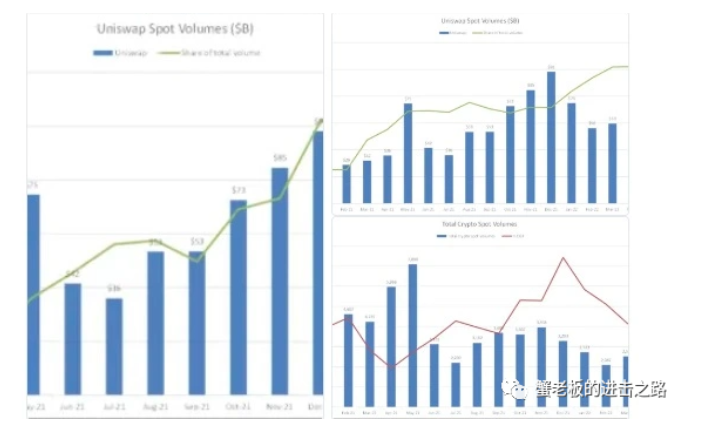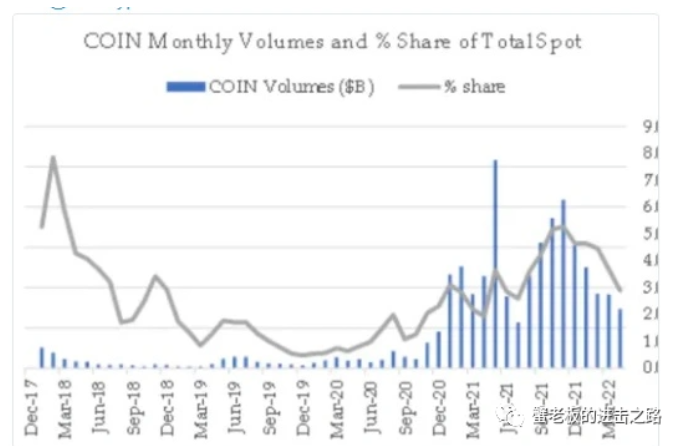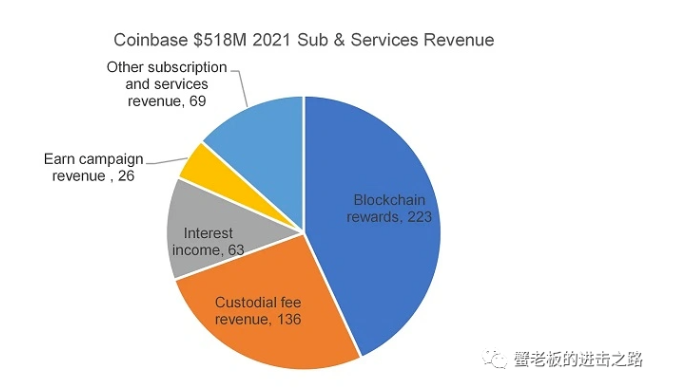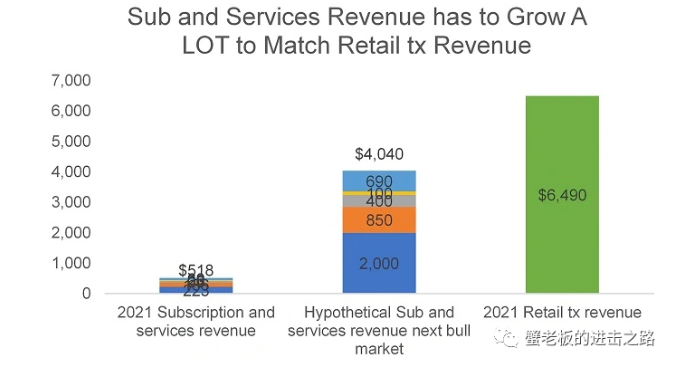In 2021, Coinbase generated $8 billion in revenue, $3.6 billion in net income, and $14 in EPS, but now, no one knows whether Coinbase will be able to return to its former glory. This article will focus on analyzing Coinbase’s medium and long-term prospects in order to give people a deeper understanding of this “listed crypto exchange”.
In April 2021, before Coinbase went public, CEO Brian Armstrong demonstrated the following PPT to investors:

It can be seen from this that Coinbase positions itself as a Web 3 platform focused on "realizing economic freedom", but if we look at Coinbase's financial situation at the time, we will find that Coinbase should actually be a lucrative encrypted retail brokerage company. 88% of net revenue in 2021 will come from retail transaction fees, 5% from institutional transaction revenue, and the remaining 7% from "subscription and service revenue" (as shown in the chart below).

Breaking down the 2021 performance further, Coinbase facilitated $1.7 trillion in trading volume in 2021, 68% of which came from institutions and 32% from retail. While institutional trading volume was more than double that of retail trading volume, Coinbase saw an 18-fold increase in retail revenue. Why? It's simple: retail trading is more profitable than institutional trading. Coinbase's 2021 retail transaction's blended rate of return reaches 1.21%, while the institutional transaction's blended rate of return is only 0.03%, a difference of about 4,000 times (as shown in the figure below).

When thinking about Coinbase's medium to long-term prospects, we must ask two questions:
Is Coinbase's retail trading revenue stream sustainable?
Can Coinbase's other revenue streams grow to a greater size?
secondary title
Coinbase’s Retail Trade Revenue Is Unsustainable
The main problem for Coinbase over the next three to five years is that the retail customer base cannot support the company's fundamentals until some other revenue stream explodes. For the primary retail user base, Coinbase cryptocurrency brokerage will charge a minimum commission rate of 1.49%, and for small USD transactions, the effective rate will even be higher than 10%; on the other hand, the highest commission rate of Coinbase Pro is only 0.60%, 50% lower than Coinbase's overall commission rate-from this perspective, retail users may feel that they are "cheated", after all, everyone will not be so "ignorant" forever.
More importantly, Coinbase also needs to face three other challenges:
Challenges from centralized exchanges: Coinbase has two of its biggest competitors, Binance and FTX. The former offers more than 600 cryptocurrencies, and its subsidiary Binance US offers "more than 100" cryptocurrencies; FTX offers more than 300 cryptocurrencies. Company FTX US offers "more than 20 cryptocurrencies". In contrast, Coinbase has certain disadvantages. According to the shareholder letter in the first quarter of 2022, Coinbase currently supports 212 asset custody and 166 asset transactions, perhaps its advantages are limited to the US market;
Challenges from traditional financial institutions: Once the regulatory status of cryptocurrencies is clarified in the next few years, traditional financial giants such as Goldman Sachs and JPMorgan Chase will undoubtedly enter this field, and the competitive pressure on Coinbase is bound to increase further;
Challenges from decentralized exchanges: Uniswap, a decentralized exchange, has over 1,000 tokens available on its platform with a transaction fee of only 0.3%. DEXs have been grabbing crypto trading market share, and this trend is likely to continue (as shown in the chart below).

Not only that, but data on crypto spot trading volumes suggests that Coinbase’s market share has also been trending lower in 2022 (as shown in the chart below).

secondary title
Coinbase's revenue streams are wildly uneven
Coinbase's income stream is "partial" and it is almost impossible to replace its core retail trading business income with other income.
In 2021, 7% of Coinbase's revenue will come from so-called "subscription and service revenue", which is divided into five separate segments: blockchain reward revenue, custody fee revenue, interest revenue, commission-earning activity revenue, and other revenue, as follows As shown in the figure:

Next, let's estimate the future prospects of these income streams according to the most optimistic scenario-
Blockchain Reward Income: This income source is the staking rewards Coinbase receives from running validators (primarily Ethereum). Assuming that in the next cycle, Ethereum can reach the upper limit of 1 trillion US dollars and generate a 5% pledge rate of return with a 30% pledge rate, which is equivalent to an addressable market value of 15 billion US dollars pledged every year. If Coinbase can maintain the current 14 % of the network market share, it is equivalent to about $2 billion in block reward revenue.
Custody Fee Revenue: Coinbase charges its customers fees for custody of crypto assets. In 2021, Coinbase managed $234 billion in cryptoassets and earned $136 million in custody fee revenue, implying a term custody fee rate of approximately 0.06%. Assuming that the total crypto market capitalization reaches $10 trillion in the next cycle, and Coinbase maintains its current market share of custody assets, its custody revenue will increase by 6.25 times to $850 million.
Interest income: Coinbase will get a share of the interest income earned by hosting customers’ fiat funds through the platform. Assuming that this income item grows with the growth of custody fee income, it can obtain approximately US$400 million in income.
Commission earning activity income: For customers who participate in specific blockchain protocol educational content, Coinbase will draw commissions from the cryptocurrencies they earn, which is expected to earn about $100 million in revenue in the next cycle.
Other subscription and service revenue: This revenue mainly comes from the encrypted infrastructure platform Coinbase Cloud. Assuming that this revenue source can grow 10 times in the next cycle, Coinbase is expected to earn $690 million in revenue.
secondary title

Other Coinbase Questions
Coinbase currently has three other thorny issues:
Overstaffed. Currently, Coinbase has more than 6,000 full-time employees, second only to Binance, which has more than 8,000 employees (but Coinbase's spot trading volume is only about 10% of Binance's), and much higher than FTX, which has about 600 employees.
There is no derivatives business. At this stage, FTX is working hard to push the U.S. Commodity Futures Trading Commission to clarify regulatory measures for encrypted derivatives business. As long as clear regulation is given, Coinbase should enter this field, but it is bound to lag behind Binance and FTX, which dominate the current market
epilogue
epilogue
Overall, it is almost certain that Coinbase's core retail trading business is very lucrative but not sustainable, and that in the long run, this revenue stream will likely taper off and eventually go to zero. On the other hand, Coinbase's subscription and services business is unlikely to displace retail transaction revenue anytime soon. To make matters worse, Coinbase's attempts to expand beyond retail trading haven't worked out well, most notably with its NFT marketplace.
A sober analysis of Coinbase's business suggests that the company faces a highly uncertain and unfavorable fundamental path over the next three to five years, making it unlikely to succeed again anytime soon, and possibly never.
I hope this article will be of some help to you.